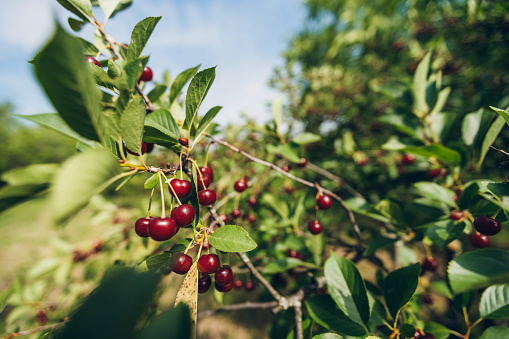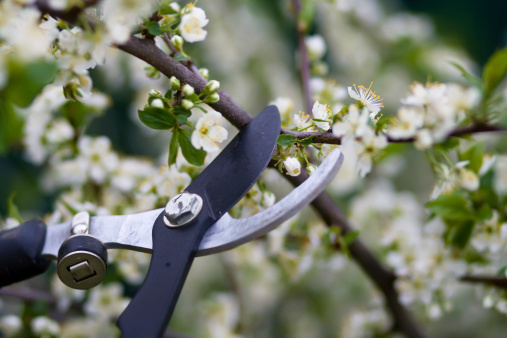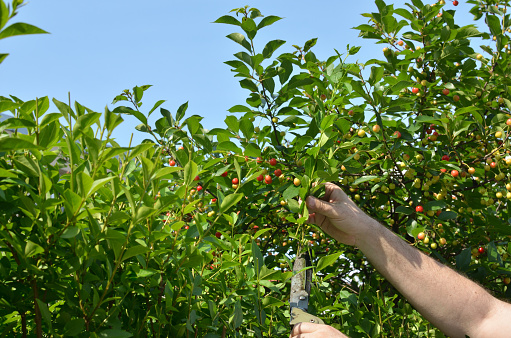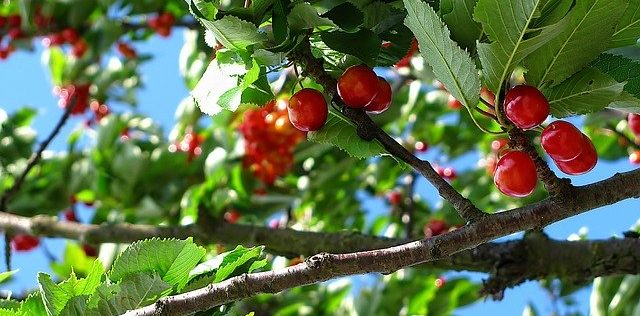Cherry trees, just like other fruit bearing trees, need to be pruned properly in order for them to produce their delicious natural treats to us, year after year. But pruning isn’t just going straight at it armed with a razor-sharp pair of secateurs or loppers. No, no, no. Pruning your cherry trees in order to get the most out of them requires a little knowledge.
Fortunately, we are armed with that knowledge here at Garden Toolbox, and we are here today to share everything we know about how to prune a cherry tree, with you.
So, without further delay, let’s crack on shall we?
How to prune a cherry tree: Why do it?

There are a few reasons for trimming back your cherry trees, but the main one is to allow more sunlight and air to penetrate to every part of the tree, and therefore keep the tree healthy. It also helps you to spot any problems with disease or pests and treat them more efficiently too. By pruning a cherry tree properly, you are helping to guide it into its healthiest form and at the same time reaping the rewards through the increased fruit yield and higher quality.
When is the best time to prune a cherry tree?
Cherries, like plums, are ‘stone fruits’. And, just like plums, they are very susceptible to silver leaf disease if you prune the tree in Autumn or winter, so you should avoid this completely. Early to mid-summer is the ideal time to prune a cherry tree as the tree is growing at this time and this makes it easier for it to fight off any possible diseases.

Initial, light pruning can be carried out in mid-spring, but leave the majority of your trimming should be done in the summer, and even then you should stick to thinning cuts or you could cause the tree to produce less fruit, due to the reduction in energy the tree has.
If you notice a broken branch on your cherry tree, it is best to cut that off straight away, but only cut back to where the branch is solid again, and make sure you use a sharp pair of secateurs for a nice clean cut.
How to prune a cherry tree: First year
Pruning a one year old cherry tree properly is essential for establishing a structure that will grow into a healthy, fruit bearing tree. A tree this young should be pruned in late march, not in summer like a fully developed tree, and just requires you to clip the stem back to about a metre in height, but this might alter slightly depending on where the buds on the stem are. These buds will grow into branches so be careful not to cut off any that seem like they will develop in a good position.
Just like when pruning plum trees, do it on a dry day and make the cuts angles so moisture can’t form there which will encourage fungus, and we certainly don’t want that.
How to prune a cherry tree: years two and three
For a two-year-old cherry tree, you should prune it in mid to late June. The aim here is to establish your main branches and trim them back to around 35-40cm, and prune the side shoots found on these branches too. Cutting these back to a length of around 12-15cm should be about right. All the other branches and stems can be pruned back to the trunk of the tree, or as close as you can get. In the third year you repeat the process, trying to make the centre of the tree less cluttered so air and light can get in.
Will I prune my cherry trees the same every year after the first?
No, in the first three years the objective of the pruning process is to develop a branch structure that will help the tree grow healthily and bear fruit. It is unlikely that the tree will produce much, if any fruit in those first few years so don’t worry about which branches to prune.

After the first three years, things change a little, and the emphasis is not on shaping the tree, but more on keeping it healthy and preventing the spread of disease. This is done by inspecting the branches and cutting away any damaged or infected ones, and also any that may be crossed over each other.
On top of preventing the spread of disease, you want to make sure that the younger branches at the centre of the tree are getting a good amount of air and sunlight, so this is another objective when it comes to your pruning after the initial three years.
The quality of the fruit on cherry tree branches declines as the wood gets older, so this is yet another reason for the ‘out with the old and in with the new’ mentality. Any branches that are over five years old should be cut away to promote the growth of younger ones that produce better fruit.
By following these instructions, you should be able to produce some healthy cherry trees capable of producing delicious fruit for you and the family.
Always be careful not to leave broken branches on the trees, and avoid pruning in winter at all costs or you might lose branches and even the whole tree to fungal diseases.
We hope that you enjoyed this article, and found it both clear and informative. It is our goal to provide easy to digest articles on all things gardening, from how to DIY articles, to growing and care taking tips for a wide range of plants.
We even have taken the time to test and review the latest gardening equipment and products, and have written up our findings in our review articles. So, if you’re in the market for a new pair of secateurs, loppers, or even a lawnmower, be sure to check out what we say about the latest products before you spend your hard-earned cash.
Until next time.
